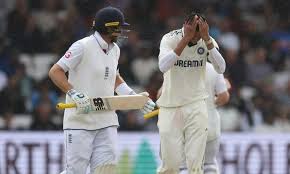Headingley whodunit: Coloured coats, black line in stands, crowded stands and general sloppiness conspire dropped catches

In Test cricket, the difference between winning and falling short often comes down to a single dropped catch. One split-second slip can turn a match on its head. At Headingley this week, that exact scenario played out — but in a puzzling, almost comic fashion. England’s fielders dropped catch after catch, leaving fans frustrated and baffled. However, a closer look suggests this wasn’t just poor fielding. Something stranger was at work.
This wasn’t a typical off day. It was a cricketing mystery, and multiple suspects were in play.
Too Many Drops, Too Many Questions
Right from the start, England’s fielders seemed off. Straightforward catches slipped through hands. Reliable players misjudged easy opportunities. It wasn’t just one or two errors — it was a series of mistakes that raised eyebrows.
Commentators and former players quickly noticed the pattern. They weren’t just criticizing individual efforts. They were pointing to something deeper, something odd. With six or more chances missed, the team looked unusually out of sync.
A Crowd Too Loud — and Too Distracting
Many pointed fingers at the crowd. Headingley has always been a lively venue, with fans full of passion. But this time, it wasn’t just about noise. It was about what fans wore — and what that did to the players’ concentration.
Bright shirts, rainbow wigs, neon jackets, and flag-draped spectators created a visual storm. One group waved massive cardboard cutouts that kept bobbing around. The fielders didn’t just have to watch the ball; they had to see through this colour explosion.
An odd black stripe on the advertising hoardings added to the mess. Positioned just behind the slips, it ran parallel to the pitch. This black line, combined with moving fans, may have distorted depth perception. The white ball disappeared into the chaos — and that’s when errors happened.
The Mystery of the Red Raincoats
Another detail made things worse. Behind the slip cordon, a group of fans wore bright red and orange coats. Under overcast skies, those colours clashed sharply with the ball. For a fielder expecting to see white against a neutral background, the effect was distracting.
Even sharp-eyed professionals can lose focus when their view gets blocked. Some England players hinted that spotting the ball wasn’t easy, especially in the slips. Team staff noticed it too and shared concerns with the match officials.
Carelessness or Confusion?
Still, not every error came from outside forces. A few catches were regulation ones — balls you expect any international player to take. Veterans like Jonny Bairstow and Joe Root admitted they weren’t sharp. Fatigue, pressure, and momentary lapses all played a part.
But cricket is a sport of fine margins. Small details — lighting, colour contrast, crowd movement — can affect performance. In a tight match, even a minor distraction can make a major difference.
Research backs this up. A Loughborough University study once showed that background colours and moving objects can disrupt a fielder’s visual tracking. Players often rely on instinct and split-second reactions. When their eyes catch conflicting colours or motion, hesitation creeps in — and the ball hits the ground.
How Can Cricket Tackle This?
This strange case poses a real question: Should cricket grounds control what appears in players’ lines of sight? Some stadiums already use neutral-coloured seating. Others restrict advertising around the sight screen.
England’s management might push for more visual consistency. Could fan areas behind key fielding positions be toned down? Is it time for uniform advertising panels, or fewer colour-clashing distractions?
Nobody wants to dull the crowd’s excitement. Test cricket thrives on energy, costumes, chants, and the occasional beach ball. But when these things start affecting the game itself, a balance becomes necessary.
Conclusion: Clues in Every Corner
Who caused the Headingley mess? The fielders? The crowd? The black lines or the red coats?
The truth is more complex. Multiple small factors came together — tired minds, chaotic visuals, and a wild crowd — to create the perfect storm. It wasn’t just one mistake or one person. It was a blend of cricket’s human side and its unpredictable surroundings.
England’s fielders will learn from this. Their next training session will likely involve extra drills and sharper focus. Meanwhile, match organizers may rethink how modern stadiums affect the game’s fine details.
Headingley 2025 won’t be remembered for its batting or bowling. Instead, it stands as a reminder that even elite athletes can falter when vision blurs and the background becomes the battlefield.






